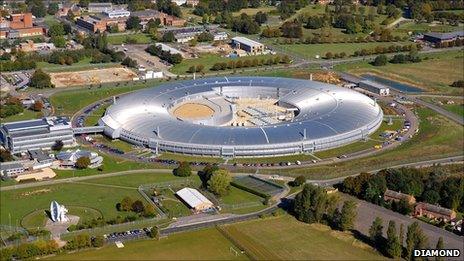How science was saved from the axe
- Published

Diamond synchrotron (a type of particle accelerator) is the largest UK-funded facility to be built in England for 40 years
As the dust is settling on a brutal spending round, the scientific community is beginning to suspect that it might have done all right.
While other budgets have received sizable cuts, science has been awarded a freeze on its funds over four years - which amounts to a 10% cut in real terms.
But those close to negotiations with the Treasury say that they were within a whisker of having very deep cuts that could have led to the closure of research institutes, the withdrawal from major international programmes and the departure of talented scientists from the UK.
They say it was only an "11th hour" intervention by the Business Secretary Vince Cable and in particular the Science Minister David Willetts that the department got what the Prime Minister David Cameron described as "a good deal for science".
"More for less"
Only last month Vince Cable said that the scientific community had to do "more for less" and (mistakenly) that "something in the order of 45% of the research grants that were going through were going to research that was not of excellent standard".
Earlier, UK Business Secretary Vince Cable said that the scientific community had to do "more for less"
Many interpreted those comments as paving the way for cuts of around 25%.
The scientific community's difficulty was that it had received huge support in the past from Gordon Brown and John Kingman, a former senior civil servant at the Treasury.
After both men had gone, there was a feeling that the Treasury had reverted to type.
Officials tended to react against arguments that over the long term an investment in science benefited the economy.
This was coupled with the fact that neither David Cameron nor George Osborne was familiar with the world of science.
'Innovation agenda'
Instinctively both men felt that the so-called "innovation agenda" of transforming scientific research into goods and services to benefit the economy was very much a New Labour view of the world.
But faced with having the UK's strong science base demolished, the Government's Chief Scientist John Beddington and director-general of science and research Adrian Smith went hard to work making the case to Treasury officials, while David Willetts and Vince Cable pressed Ministers.
Annoyingly for the Treasury, the officials and ministers arguing the case for science were arguing a good case.
Beddington, Smith, Willetts and Cable were giving them the hard evidence that they'd asked for, which did demonstrate the value of the science base to the UK economy.
But they had their targets and would not budge.
One source said that treasury officials looked "faintly embarrassed" when in the face of such a convincing argument they were still insisting on deep cuts that would have, in the view of those campaigning against cuts, irreversibly damaged UK research and Britain's universities.
But with less than a day to go, the science team pressed their case that for a relatively small amount of money, David Cameron and George Obsorne could offer a ray of hope amongst all the gloom: that growth could come from investment in the UK's research base.
Awaiting details
As the pieces of the spending review fell into place, the Treasury found that it did have the loose change to offer science a freeze (and protection) on its funding over four years.
Officials at the Office of Science have been urging the scientific community to "get behind" the deal and to give Cameron and Osborne credit for the fact that they have recognised that they have accepted the view that science is "vital" to the UK's economic growth.
While offering public support, many are waiting to see the detail.
Of particular concern is the fact that so-called capital spending, which accounts for 20% of the spending of research councils, was stripped out of the spending review announcement.
This was done so that ministers could have the headline that the science budget was frozen over four years.
But if the capital budget receives a sizable cut as is widely expected, then the shine will be taken off "the great deal for science".
- Published20 October 2010
- Published20 October 2010
- Published20 October 2010